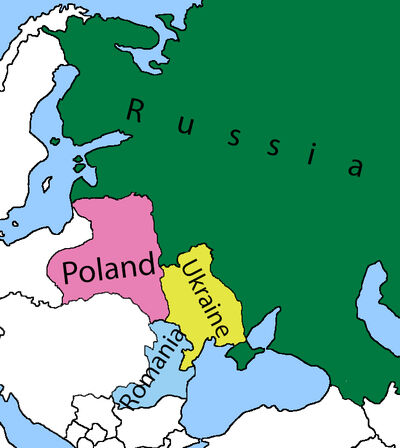First Russian War (6 March 1930-6 February 1933 (peace treaty with Ukraine and Poland) or 29 March (ending of military actions in Russian Empire)) (also known as Russian Civil War) was a military conflict between Tsarists, Oppositionists and national minorities seeking independence. The war has claimed lives of 400.000 combatants, but ensuing terror, ethnic cleansing, famine and plague have killed three to five million people, making it the deadliest conflict of 20th century.
Background[]
Tensions have been rising in the Russian Empire, from the beginning of 20th century. 1905 revolution saw no major successes, but absolute rule of Tsar, poverty and growing inequality created militant population. When in 1929 crisis begun, Russia was one of the worst hit countries. Its unindustrialized economy based on wheat exports has crushed, leading to massive unemployment, widespread hunger and starvation and militancy. Tsar ordered strikes to be crushed with force, which led to full scale civil war in March 1930.
Communists and Tsarists[]
Massive strikes forced the Tsar to escape to Vladivostok. Largely supported by the population, Communists seized most of European ethnic Russia in 1930. In September, the Bolsheviks attempted to take Kiev, but were beaten by troops commanded by general Denkin, allied to local Ukrainian nationalists and Cossacks. Denkin's offensive succeeded at taking Voronezh and Tsaritsyn and Wrangel's White soldiers took Astrahan, leaving Bolsheviks cut off from revolutionary Caucasus. In July, white general Kolchak crossed the Ural Mountains from Siberia and launched an offensive, that culminated in taking of Kazan and merging with Denkin's army. Bolshevik launched moderately successful attack of Belarus, but in January Wrangel and Kolchak attacked Moscow in what came to be known as "bloody winter". The workers and Communists fought for every inch of land to the last man. In spite of that Moscow was back in the Tsar's hands in June. Communist leader - Joseph Jugashvili (AKA Stalin) was executed while his right hand man - Leon Bronstein (AKA Trotsky) fled to Austria-Hungary, where he became a member of the Third International.
New enemies[]
From the beginning, nationalist movement were divided amongst who to support. Poland, Lithuania, Latvia, Estonia and Finland quickly took opportunity to declare independence from Russia. Ukrainians though, sought alliance with the Tsar, who promised many freedoms and possibly even independence. Other nations like Tatars, Caucasians and Turkic people in Asia largely lacked national consciousness and no coherent independence movement appeared in these countries. Poland declared independence on 16 April 1930 and under ultra-nationalist leadership of Roman Dmowski launched an attack on newly independent Lithuania and quickly defeated small nation. In Dmowski's irredentist concept, Poland was supposed to own western Ukraine and Belarus, which were part of Polish-Lithuanian Commonwealth. This led to conflict with Tsar-aligned Ukraine and Belarus and made Poland uneasy ally of the Bolsheviks. As soon as tide turned against Bolsheviks and in face of increasing repressions by the Tsar, Ukrainian leadership broke their alliance and formally declared independence on 25 May 1931. In Ukraine, liberal, social-democratic leadership came to power. This led to situation where, within the borders of Russian Empire, existed six new states (Poland, Lithuania, Latvia, Estonia, Finland and Ukraine) Russia wasn't recognising. Lithuania was occupied by Polish troops and Latvia and Ukraine were simultaneously at war with Russia and with Poland which was technically at war with Russia too, although de facto, Poland and Russia didn't share a border, in spite of the fact that whole war was taking de jure part within borders of Russian Empire.
Ukrainian government proved incapable of fighting a war with Poles and Russians. Russia launched an attack in eastern Ukraine, which took large swaths of Ukraine including Ukrainian capital Kiev. Simultaneously Poland attacked Ukraine and marched deep into Ukrainian territories. Poland saw that Russia was now a biggest threat to their independence, and signed treaty with Ukraine, that ceded Volhynia and Podolia to Poland. Now united against their common enemy, Polish-Ukrainian forces defeated Russians in Kiev in winter 1931 and in Minsk in early 1932. Faced with country in utter chaos, Tsar was forced to negotiate. In December 1932, armistice was signed and on 6 February 1933, peace treaty was signed in Rostov.
Peace and aftermath[]

Europe after Treaty of Rostov
Peace was signed by three signatories: Poland, Ukraine and Russian Empire. Terms of the treaty were as followed:
- Russia was supposed to recognise Poland and Ukraine.
- Poland was given, in addition to ethnic Polish territory, most of Belarus, Volhynia and Podolia in Ukraine and Lithuania.
- Ukraine was treated as defeated country, it was forced accept border with Russia that run from along Isthmus of Perekop, to Dnieper River and than 100 km east from Kiev.
- Recognition of union between part of Bessarabia and Romania.
- Peace treaty contained secret addendum, that contained agreement for Russian re-annexation of Finland, Estonia and most of Latvia, except for area around city of Wenden, which was to be given to Poland.
Soon after peace negotiations ceased, Russia invaded newly formed countries as per treaty, which were too small and unprepared to put up any defences. This was met with wide international condemnation. Peace treaty created a sense of disappointment in Ukraine, which led to rise of fascism, inspired by Italian fascists. It also contributed to even higher ethnic instability, because of growing independence movement in minority nationalities.
